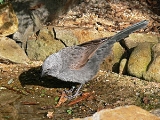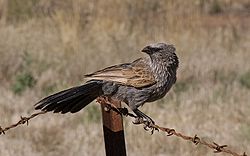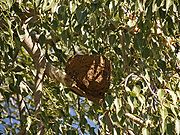
Apostlebird
Encyclopedia
The Apostlebird also known as the Grey Jumper, is a quick-moving, gray or black bird
about 13 inches (33 centimetres) long. It is a native to Australia
where it roams woodland
s, eating insects and seeds at, or near, ground level. Apostlebirds often travel in groups of about 12; for this reason they were named after the Biblical
apostles, the twelve chief followers of Jesus Christ.
 Originally described by ornithologist John Gould
Originally described by ornithologist John Gould
in 1837, its specific epithet is Latin
cinerea "grey". In its own genus
Struthidea, it is placed in the family known as the mud-nest builders or Corcoracidae, written as Grallinidae in older books before the removal of the genus Grallina
to the Wagtail family. It is one of two remaining species, with the White-winged Chough
(Corcorax melanorhamphos), which differs in appearance but exhibits many behavioural similarities. The mudnest builder family Corcoracidae itself is now placed in a narrower "Core corvine" group, which contains the crows and ravens, shrikes, birds of paradise, fantails, monarch flycatchers, and drongos.
The Apostlebird was named after the Biblical apostles, the twelve followers of Jesus Christ. In fact, the species travel in family groups of between 6 and 20, which may coalesce with other family groups into large feeding flocks of over 40. Their gregarious nature, and harsh scolding/grating calls have led to a plethora of colloquial names. They can be known locally as Lousy Jacks (due to heavy louse infestations), Happy Jacks, Happy Families and CWA Birds. The latter name is mildly derogatory, referring to the supposed resemblance of Apostlebird's constant chatter to a Country Women's Association
meeting. Grey Jumper is an alternate name.
. There is an isolated population in the Northern Territory. Dry open woodland is the preferred habitat, especially Callitris
in New South Wales and Casuarina
in Queensland, and Lancewood-Bulwaddi communities in the Northern Territory.
 Apostlebirds are a socially living, cooperative breeding species with each breeding group generally containing only one breeding pair, the rest being either their helper
Apostlebirds are a socially living, cooperative breeding species with each breeding group generally containing only one breeding pair, the rest being either their helper
offspring, kin or unrelated adult birds. Most group members help construct a mud nest, share in incubation of the eggs, and defense of the nest. Once the eggs are hatched, all members of the group help feed the chicks and keep the nest clean.
Apostlebirds are a fission-fusion society. In winter, birds flock in larger groups, and as breeding season approaches winter groups break into smaller breeding groups. This change in group size is a consequence of breeding groups merging in the winter and breaking apart again in the summer breeding season. Breeding groups use small, non overlapping home ranges around the nest site, while winter ranges are larger with groups freely interacting with other groups[9].
Breeding season is from August to December. The nest is a deep cup-shaped structure made of grasses held together with mud or sometimes manure in a tree fork up to seven or eight metres above the ground. Three to five pale blue-white eggs sparsely splotched with brown and lavender shades are laid measuring 22 mm x 29 mm. They are tapered oval in shape.
. However, their conservation status varies from state to state within Australia. For example:
Bird
Birds are feathered, winged, bipedal, endothermic , egg-laying, vertebrate animals. Around 10,000 living species and 188 families makes them the most speciose class of tetrapod vertebrates. They inhabit ecosystems across the globe, from the Arctic to the Antarctic. Extant birds range in size from...
about 13 inches (33 centimetres) long. It is a native to Australia
Australia
Australia , officially the Commonwealth of Australia, is a country in the Southern Hemisphere comprising the mainland of the Australian continent, the island of Tasmania, and numerous smaller islands in the Indian and Pacific Oceans. It is the world's sixth-largest country by total area...
where it roams woodland
Woodland
Ecologically, a woodland is a low-density forest forming open habitats with plenty of sunlight and limited shade. Woodlands may support an understory of shrubs and herbaceous plants including grasses. Woodland may form a transition to shrubland under drier conditions or during early stages of...
s, eating insects and seeds at, or near, ground level. Apostlebirds often travel in groups of about 12; for this reason they were named after the Biblical
New Testament
The New Testament is the second major division of the Christian biblical canon, the first such division being the much longer Old Testament....
apostles, the twelve chief followers of Jesus Christ.
Taxonomy

John Gould
John Gould was an English ornithologist and bird artist. The Gould League in Australia was named after him. His identification of the birds now nicknamed "Darwin's finches" played a role in the inception of Darwin's theory of evolution by natural selection...
in 1837, its specific epithet is Latin
Latin
Latin is an Italic language originally spoken in Latium and Ancient Rome. It, along with most European languages, is a descendant of the ancient Proto-Indo-European language. Although it is considered a dead language, a number of scholars and members of the Christian clergy speak it fluently, and...
cinerea "grey". In its own genus
Monotypic
In biology, a monotypic taxon is a taxonomic group with only one biological type. The term's usage differs slightly between botany and zoology. The term monotypic has a separate use in conservation biology, monotypic habitat, regarding species habitat conversion eliminating biodiversity and...
Struthidea, it is placed in the family known as the mud-nest builders or Corcoracidae, written as Grallinidae in older books before the removal of the genus Grallina
Grallina
Grallina is a genus composed of two species of passerine bird native to Australia and New Guinea. It is a member of a group of birds termed monarch flycatchers. This group is considered either as a subfamily Monarchinae, together with the fantails as part of the drongo family Dicruridae, or as a...
to the Wagtail family. It is one of two remaining species, with the White-winged Chough
White-winged Chough
The White-winged Chough is one of only two surviving members of the Australian mud-nest builders family, Corcoracidae, and is the only member of the genus Corcorax...
(Corcorax melanorhamphos), which differs in appearance but exhibits many behavioural similarities. The mudnest builder family Corcoracidae itself is now placed in a narrower "Core corvine" group, which contains the crows and ravens, shrikes, birds of paradise, fantails, monarch flycatchers, and drongos.
The Apostlebird was named after the Biblical apostles, the twelve followers of Jesus Christ. In fact, the species travel in family groups of between 6 and 20, which may coalesce with other family groups into large feeding flocks of over 40. Their gregarious nature, and harsh scolding/grating calls have led to a plethora of colloquial names. They can be known locally as Lousy Jacks (due to heavy louse infestations), Happy Jacks, Happy Families and CWA Birds. The latter name is mildly derogatory, referring to the supposed resemblance of Apostlebird's constant chatter to a Country Women's Association
Country Women's Association
The Country Women’s Association of Australia is the largest women's organisation in Australia. It has 44,000 members across 1855 branches. Its aims are to improve the conditions for country women and children and to try to make life better for women and their families, especially those women...
meeting. Grey Jumper is an alternate name.
Description
Measuring around 33 cm (13 in) in length, the Apostlebird is a predominantly dark grey bird with a long black tail tinted greenish in sunlight. The grey feathers on the head, neck and breast are brushed with paler grey-white and the wings are brownish. The legs and bill are black and the eyes brown or white.Distribution and habitat
The natural range is across inland eastern Australia, from the mallee regions of northern Victoria and eastern South Australia, north through New South Wales and central-western Queensland to the Gulf CountryGulf Country
The Gulf Country is the name given to the region of woodland and savanna grassland surrounding the Gulf of Carpentaria in north western Queensland and eastern Northern Territory on the north coast of Australia...
. There is an isolated population in the Northern Territory. Dry open woodland is the preferred habitat, especially Callitris
Callitris
Callitris is a genus of coniferous trees in the Cupressaceae . There are 15 species in the genus, of which 13 are native to Australia and the other two native to New Caledonia. Traditionally the most widely used common name is cypress-pine, a name shared by the closely related genus Actinostrobus...
in New South Wales and Casuarina
Casuarina
Casuarina is a genus of 17 species in the family Casuarinaceae, native to Australasia, southeast Asia, and islands of the western Pacific Ocean. It was once treated as the sole genus in the family, but has been split into three genera .They are evergreen shrubs and trees growing to 35 m tall...
in Queensland, and Lancewood-Bulwaddi communities in the Northern Territory.
Breeding

Helpers at the nest
Helpers at the nest is a term used in behavioural ecology and evolutionary biology to describe a social structure in which juveniles and sexually mature adolescents of either one or both sexes, remain in association with their parents and help them raise subsequent broods or litters, instead of...
offspring, kin or unrelated adult birds. Most group members help construct a mud nest, share in incubation of the eggs, and defense of the nest. Once the eggs are hatched, all members of the group help feed the chicks and keep the nest clean.
Apostlebirds are a fission-fusion society. In winter, birds flock in larger groups, and as breeding season approaches winter groups break into smaller breeding groups. This change in group size is a consequence of breeding groups merging in the winter and breaking apart again in the summer breeding season. Breeding groups use small, non overlapping home ranges around the nest site, while winter ranges are larger with groups freely interacting with other groups[9].
Breeding season is from August to December. The nest is a deep cup-shaped structure made of grasses held together with mud or sometimes manure in a tree fork up to seven or eight metres above the ground. Three to five pale blue-white eggs sparsely splotched with brown and lavender shades are laid measuring 22 mm x 29 mm. They are tapered oval in shape.
Conservation status
Apostlebirds are not listed as threatened on the Australian Environment Protection and Biodiversity Conservation Act 1999Environment Protection and Biodiversity Conservation Act 1999
The Environment Protection and Biodiversity Conservation Act 1999 is an Act of the Parliament of Australia that provides a framework for protection of the Australian environment, including its biodiversity and its natural and culturally significant places...
. However, their conservation status varies from state to state within Australia. For example:
- The Apostlebird is listed as threatened on the Victorian Flora and Fauna Guarantee Act (1988). Under this Act, an Action Statement for the recovery and future management of this species has not yet been prepared.
- On the 2007 advisory list of threatened vertebrate fauna in Victoria, the Apostlebird is not listed as a threatened species.
External links
- APOSTLEBIRDS Corcoracidae
- Apostlebird videos, photos & sounds on the Internet Bird Collection

